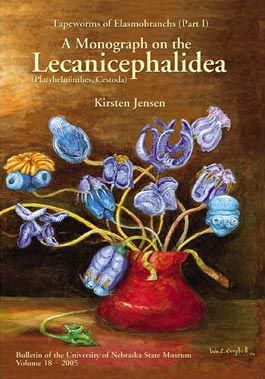
Museum Bulletins
Volume 18
Tapeworms of Elasmobranchs (Part I) A Monograph on the Lecanicephalidea (Platyhelminthes, Cestoda)

Volume: 18
Author(s): Kirsten Jensen, 2004. 241 pages.
Abstract
This represents the first monographic and phylogenetic treatment of the order Lecanicephalidea. The main objective was to treat the Lecanicephalidea at the generic level, while providing information on morphology, taxonomic history, phylogenetic relationships, geographic distribution, and host associations of the group. Following an introduction to the morphology of the Lecanicephalidea, the phylogenetic placement of the group is addressed. This is followed by a review of the taxonomic history of the group and relationships within, including summaries of 29 previously used classification schemes. Despite the generic focus of this study, the taxonomic status of 137 previously recognized lecanicephalidean species was evaluated, resulting in 65 species considered to be valid, 52 species considered to be species inquirendae, 14 considered to be nomina nuda, four considered to be non-lecanicephalidean species inquirendae, and two species considered to not be belong to the Lecanicephalidea. Two type species, Lecanicephalum peltatum and Polypocephalus radiatus, and Anteropora japonica are redescribed. Seven new species are described. These are: Anteropora leelongi Jensen, n. sp., Eniochobothrium euaxos Jensen, n. sp., Hornellobothrium extensivum Jensen, n. sp., Lecanicephalum coangustatum Jensen, n. sp., Polypocephalus helmuti n. sp., Tetragonocephalum passeyi Jensen, n. sp., and Tylocephalum koenneckeorum Jensen, n. sp. Five new combinations were created for lecanicephalidean species (Polypocephalus caribbensis n. comb., P. elongatus n. comb., Tetragonocephalum madhualtae n. comb., Tetragonocephalum madrassensis n. comb., and Tylocephalum rhinobatii n. comb.), and one new combination for a tetraphyllidean. Museums around the world were visited to locate type material. A list of type material is presented for 33 species. In addition, a preliminary list of voucher material of lecanicephalideans is given. The taxonomic status of 43 genera that had been associated with the Lecanicephalidea was evaluated. As a result, 16 genera are considered to belong to other cestode orders, two are considered genera inquirenda et incertae sedis (Calycobothrium and Trygonicephalum), one is determined to be a nomen nudum (Aphanobothrium), two are considered to be junior synonyms of other lecanicephalidean genera (Parataenia and Spinocephalum), nine are considered to be lecanicephalidean genera inquirenda (Anthemobothrium, Cephalobothrium, Flapocephalus, Hexacanalis, Kystocephalus, Sephenicephalum, Staurobothrium, and Thysanobothrium), one is considered to be an invalid replacement name for a valid lecanicephalidean genus (Monoporophyllaeus), and 12 are recognized to be valid members in the order (Aberrapex, Anteropora, Corrugatocephalum, Eniochobothrium, Healyum, Hornellobothrium, Lecanicephalum, Paraberrapex, Polypocephalus, Quadcuspibothrium, Tetragonocephalum, and Tylocephalum). A key to the valid genera is given. Treatment of the valid genera, in each case, includes comments on the type species and on at least one additional species (mostly the new species). New collections of lecanicephalideans from around the world formed the basis for this taxonomic work. As a result, a total of 22 lecanicephalidean species are treated. Studies mentioning or addressing the species treated here were summarized in a chronology section for each species. Each species is illustrated with a map indicating its geographic distribution, line drawings of, at a minimum, the whole worm, scolex, and proglottid. If material was available, a complete characterization of the microthrix pattern of a species, as observed with scanning electron microscopy, is presented. As part of a character analysis, identification of homologous components of apical structures in lecanicephalideans was attempted. The character analysis resulted in 64 morphological characters that were included in a series of phylogenetic analyses performed to investigate relationships among lecanicephalidean genera. These analyses included 18 lecanicephalidean species, representing the 12 valid genera, and two tetraphyllidean and proteocephalidean species each, used as outgroups. Effects of different amounts of missing data, coding strategies for inapplicable characters and the effect of outgroup selection on tree topology were investigated. None of the trees resulting from these analyses were well supported. In general, these trees suggested a monophyletic Lecanicephalidea relative to the outgroups, a basal position for lecanicephalideans lacking an apical structure, and a clade containing species possessing an apical structure, with a trend towards an increase in apical organ size within this clade. Familial boundaries remain poorly understood and unstable. Consequently, no familial classification scheme for the Lecanicephalidea is proposed at this time. As a result of the new collections, geographic distribution and host associations of the Lecanicephalidea were expanded. For example, major locality records for lecanicephalideans now included the Gulf of Mexico, the Mozambique Channel and the eastern Indian Ocean off Madagascar, the Gulf of Thailand, and the Timor and Arafura Seas off northern Australia. Lecanicephalidean host associations were expanded to include 19 new host species records, one new host genus record (the sawfish genus Pristis) and one new host family record (the bamboo shark family Hemiscylliidae). In addition, the literature on larvae identified as lecanicephalideans was summarized. Overall, an underestimated generic diversity and morphological disparity was demonstrated.





